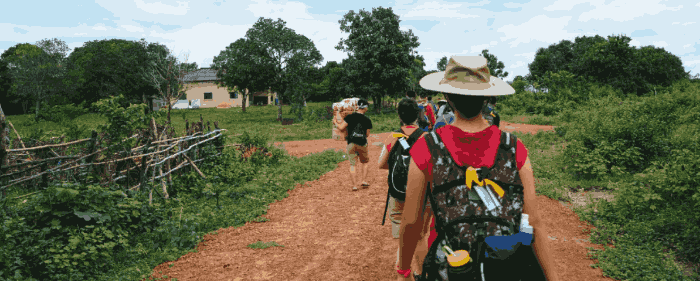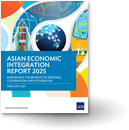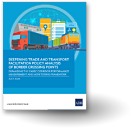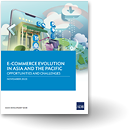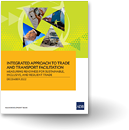Empowering Women in Tourism: The Key to a Healthy, Resilient Industry
Empowering women in tourism through targeted policies can overcome barriers like limited finance and caregiving burdens, unlocking their potential to drive job creation, sustainable innovation, and economic and health resilience in times of crisis.
Tourism has emerged as one of the fastest-growing sectors in Asia and the Pacific, with international arrivals reaching 87% of pre-pandemic levels in 2024. Women are a significant driving force in the tourism sector in Asia and the Pacific, constituting a majority of the workforce (52%). Micro-, small and medium-sized enterprises led by women are pivotal to generating jobs in tourism and spurring local development.
For instance, in Cambodia, the women’s labor force participation rate was 80% in 2019, and women constituted 60% of the tourism workforce, with many employed in small enterprises and involved in designing tours to promote culture, art, tradition, religion, food, souvenirs, and tourist attractions.
By contrast, the Maldives presents a stark contrast: home to over 160 island resorts, it has only 10% female resort employees and a mere 3% local women in 2019. In Kyrgyzstan and Tajikistan, women are predominantly employed in hospitality, tours and artisanal crafts. The tourism industries in these countries are also male dominated, with Tajikistan's employing 31% women.
Despite this diversity in national contexts, women workers and women-led small businesses face similar challenges in the tourism industry across Asia’s developing countries.
Even in countries with higher female participation, such as Cambodia, women are overrepresented in low-paid, low-skilled, and often temporary or part-time jobs that heighten job insecurity, financial instability, and a wage gap. This is a common phenomenon across developing Asian countries with lower female participation in tourism.
One of the reasons is societal expectations on women’s role as the primary caregivers at home. The significant burden on female entrepreneurs and workers to balance paid work with unpaid, domestic responsibilities restricts their ability to take more business risks and expand their networks.
A report from the International Labour Organization shows that women in Asia and the Pacific spend 4.1 times more time in unpaid care work than men. The resulting time scarcity and mobility constraints faced by women impact their ability to participate in the labor market, grasp opportunities for career advancement, invest in and expand their businesses, and achieve financial independence.
These barriers also reinforce women’s lack of collateral required for loans that are essential to access to finance. Data shows that only 17%, 36%, and 49% of women own a house alone or jointly in Maldives, Tajikistan, and Cambodia, respectively. This not only restricts their ability to borrow, invest, and grow tourism businesses but also affects broader aspects of their well-being, including nutritional security and access to healthcare.
By offering diverse cultural insights and authentic travel experiences, women-led businesses enrich the global tourism landscape.
Structural discrimination from financial institutions further limits women’s access to finance. These, in turn, reinforce women’s concentration in low-paying or less secure positions, while men tend to dominate managerial and leadership roles, intensifying these inequalities in tourism.
In addition to financial exclusion, women in tourism often face unsafe and precarious working conditions. The seasonal nature of tourism, poor working conditions faced by women in tourism, such as workplace safety and harassment, and insufficient social protection, including mental health support on overworking and childcare support, exacerbate these issues. Many women also work in the informal sector and family-owned tourism businesses with no employment benefits or safety nets.
Health and hygiene-related risks also disproportionately affect women in tourism. The lack of access to proper sanitation facilities, clean water supply, and hygiene amenities at tourism workplaces could pose risks to women's health and safety, such as their vulnerability to reproductive and urinary tract infections, privacy and violence concerns when using shared facilities, and challenges in managing menstrual hygiene.
These vulnerabilities were worsened during the COVID-19 pandemic, which caused an economic shock in the tourism industry that led to business closures and job losses. Also, it has increased unpaid care work and exposed the vulnerability of women entrepreneurs who often do not have sufficient financial reserves and support mechanisms to weather such crises.
Despite these challenges, women in the tourism industry have demonstrated resilience and innovation. In Kyrgyzstan and Tajikistan, women-led guesthouses, tour companies, and handicraft cooperatives have gained recognition for promoting personalized services and cultural heritage, attracting both domestic and international tourists and contributing to local economies.
Women can be agents of change for sustainable tourism, promoting culturally sensitive and innovative solutions. Examples of empowerment that help address inequalities and improve health and economic outcomes include:
Increasing opportunities for women in national tourism, health, and economic policies: A multisector approach to policymaking may ensure that women have equal opportunities, compensation, and support to thrive in the industry. Enhanced maternal, sexual, and reproductive health services are needed. The Tajikistan National Development Strategy 2030, which explicitly calls for the equal treatment of women in the labor market, is a promising initiative.
Creating a safe and healthy work environment for women: Addressing workplace safety, harassment, and discrimination in both public and private sectors can help women feel secure and supported. Improving health and security standards may also attract more solo and group female travelers.
Reducing barriers to obtaining loans and credit: Microfinance programs and financial products tailored to women may promote women’s access to finance for investing in and expanding their businesses, adopting new technologies, bolstering marketing efforts, and keeping businesses afloat when visitor numbers decline.
Targeted training programs and capacity-building initiatives: Networks, mentorship, legal aid, counselling services, and digital training may provide support and resources for women to navigate challenges and enhance their business skills.
Improved sex-disaggregated data for real-time, evidence-based policymaking: Women in tourism contribute to a large sector.
By accurately quantifying the scope of female entrepreneurship in tourism, officials can craft targeted interventions that bolster women’s rights, strengthen community resilience, and safeguard the natural assets that underpin local economies.
In the end, empowering women entrepreneurs in tourism benefits not only the individuals who own and operate these businesses, but also entire communities seeking inclusive, healthy, and resilient growth.
By offering diverse cultural insights and authentic travel experiences, women-led businesses enrich the global tourism landscape—while underscoring that economic development is most sustainable when it lifts everyone.
